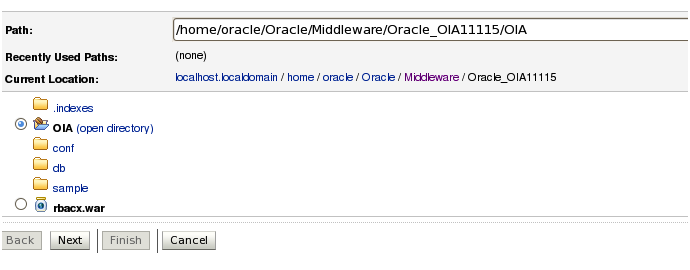These are the required steps to install Oracle Identity Analytics (OIA) 11.1.1.5 on a RHEL environment
For this post, I have Weblogic 10.3.5.0, JDK 1.6.0_24 and Oracle 11g DB installed
Download OIA 11.1.1.5
You are required to install ofm_oia_generic_11.1.1.5.0 from the Oracle website. Download here...
(Once you have done that, you will have a directory called 'ofm_oia_generic_11.1.1.5.0')
1. Rename the directory from 'ofm_oia_generic_11.1.1.5.0' to 'Oracle_OIA11115'
2. Move the 'Oracle_OIA11115' directory to your Middleware directory
cd /home/oracle/Oracle/Middleware/Oracle_OIA11115
mkdir Oracle_OIA11115
cd Oracle_OIA11115
jar -xvf ./rbacx.war
3. Copy over the jdbc.properties file from the oracle directory to the conf directory
cp /home/oracle/Oracle/Middleware/Oracle_OIA11115/conf/oracle/jdbc.properties /home/oracle/Oracle/Middleware/Oracle_OIA11115/conf
Configuring the Database
Access the Database within a terminal by executing the following:
sqlplus / as sysdba
SQL> create user rbacxservice identified by password ;
User created.execute 'rbacx-11.1.1.5.0_oracle_schema.sql' against your database
Configure the files
edit setDomainEnv.sh located at /home/oracle/Oracle/Middleware/user_projects/domains/base_domain/bin
locate the variable “WLS_MEM_ARGS_64BIT=”-Xms512m -Xmx512m” ”
change the value to ”WLS_MEM_ARGS_64BIT=”-Xmx1024m -Xms1024m” ”
Within the .bash_profile, include the following lines
RBACX_HOME=/home/oracle/Oracle/Middleware/Oracle_OIA11115
export RBACX_HOME
Within the jdbc.properties file, alter the following:
jdbc.url=jdbc:oracle:thin:@$SERVER_NAME:$PORT:rbacx
jdbc.url=jdbc:oracle:thin:@localhost.localdomain:1521:orcl
Add the following line (does not matter where you place it)
jdbc.password=password
Exit (and Save) then execute the following script:
/home/oracle/Oracle/Middleware/jdk160_24/bin/java -jar ../OIA/WEB-INF/lib/vaau-commons-crypt.jar -encryptProperty -cipherKeyProperties ./cipherKey.properties -propertyFile ./jdbc.properties -propertyName jdbc.password
This will then remove the line you added, and replace it with something like the following(jdbc.password.encrypted = 0156122a52ce964c5c835d637fcd998ce67928c6436d3a40b4
Configure the files
edit setDomainEnv.sh located at /home/oracle/Oracle/Middleware/user_projects/domains/base_domain/bin
locate the variable “WLS_MEM_ARGS_64BIT=”-Xms512m -Xmx512m” ”
change the value to ”WLS_MEM_ARGS_64BIT=”-Xmx1024m -Xms1024m” ”
Within the .bash_profile, include the following lines
RBACX_HOME=/home/oracle/Oracle/Middleware/Oracle_OIA11115
export RBACX_HOME
Within the jdbc.properties file, alter the following:
jdbc.url=jdbc:oracle:thin:@$SERVER_NAME:$PORT:rbacx
jdbc.url=jdbc:oracle:thin:@localhost.localdomain:1521:orcl
Add the following line (does not matter where you place it)
jdbc.password=password
Exit (and Save) then execute the following script:
/home/oracle/Oracle/Middleware/jdk160_24/bin/java -jar ../OIA/WEB-INF/lib/vaau-commons-crypt.jar -encryptProperty -cipherKeyProperties ./cipherKey.properties -propertyFile ./jdbc.properties -propertyName jdbc.password
This will then create an encrypted value as a replacement 'jdbc.password.encrypted'
Configure WLS
(To avoid any complications with conflict of jars, create a new OIA base domain. If wish to have 2 or more applications together, look into preferred Classloaders)
Start up the base Domain 11.1.1.5
you can use this link to create a base domain, though make sure you give it a more appropiate domain name and assign a port number that is not already taken.
Once that has been created, start the domain server by using the following:
cd /home/oracle/Oracle/Middleware/user_projects/domains/OIA_basedomain
sudo ./startWebLogic.sh
Go to the weblogic Server Admin Console
(Your hostname and port number may be different)
http://localhost.localdomain:7002/console/login/LoginForm.jsp
Within the Domain Structure window (located left-center), click on Deployments
When a new screen appears, click 'Install'
Locate your downloaded OIA repository (see picture), then click next

Ensure you click 'Install this deployment as an application' and click next

Rename the deployment as OIA and click 'finish'. You 'should' now be able to start up the Application within Weblogic and access the following link (change the hostname/port)
http://172.16.128.128:7002/OIA
http://172.16.128.128:7002/OIA

About the author
 Daniel is a Technical Manager with over 10 years of consulting expertise in the Identity and Access Management space.
Daniel is a Technical Manager with over 10 years of consulting expertise in the Identity and Access Management space.Daniel has built from scratch this blog as well as technicalconfessions.com
Follow Daniel on twitter @nervouswiggles
Comments
Other Posts
AS I was migrating my environment into an S3 environment, I wanted to leverage off the SES services that AWS provide, more specifically, to leverage the off the SMTP functionality by sending an email via PHP
Read More...
The WeMos D1 is a ESP8266 WiFi based board is an extension to the current out-of-the-box library that comes with the Arduino installation. Because of this, you need to import in the libraries as well as acknowledging the specific board. This process is highly confusion with a number of different individuals talking about a number of different ways to integrate.
Read More...
NameID element must be present as part of the Subject in the Response message, please enable it in the IDP configuration.
Read More...
For what I see, there's not too many supportive documentations out there that will demonstrate how provision AD group membership with the ICF connector using OpenIDM. The use of the special ldapGroups attribute is not explained anywhere in the Integrators guides to to the date of this blog. This quick blog identifies the tasks required to provision AD group membership from OpenIDM to AD using the LDAP ICF connector. However this doesn't really explain what ldapGroups actually does and there's no real worked example of how to go from an Assignment to ldapGroups to an assigned group in AD. I wrote up a wiki article for my own reference: AD group memberships automatically to users This is just my view, others may disagree, but I think the implementation experience could be improved with some more documentation and a more detailed example here.
Read More...
In the past, the similar error occurred though for the Oracle Identity Management solution. invalidcredentialexception remote framework key is invalid Because they all share the ICF connector framework, the error/solution would be the same.
Read More...
org.forgerock.script.exception.ScriptCompilationException: missing ; before statement
Read More...
ForgeRock IDM - org.forgerock.script.exception.ScriptCompilationException: missing ; before statement
Read More...
When performing the attempt of a reconciliation from ForgeRock IDM to Active Directory, I would get the following error
Read More...
In the past, the similar error occurred though for the Oracle Identity Management solution. invalidcredentialexception remote framework key is invalid Because they all share the ICF connector framework, the error/solution would be the same.
Read More...
During the reconcilation from OpenIDM to the ICF google apps connector, the following error response would occur. ERROR Caused by com.google.api.client.auth.oauth2.TokenResponseException 400 Bad Request - invalid_grant
Read More...

